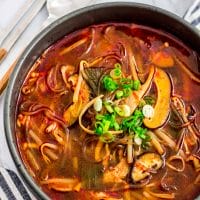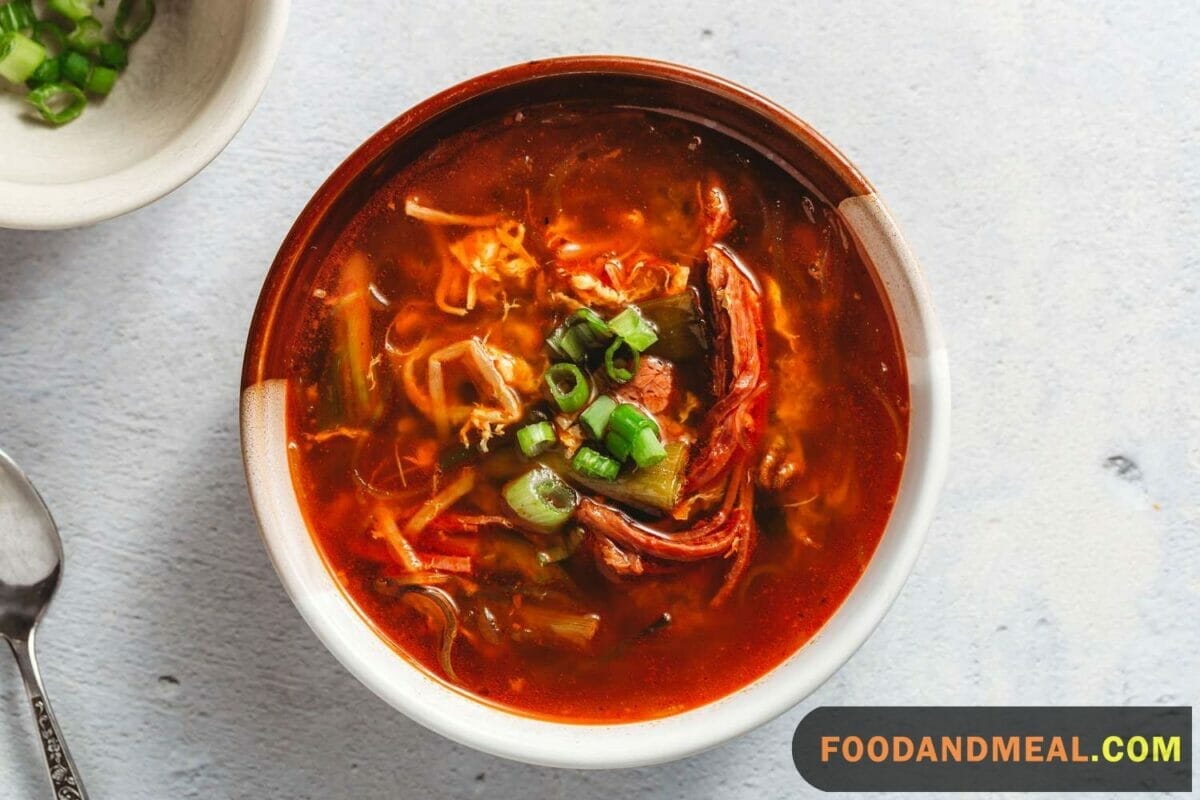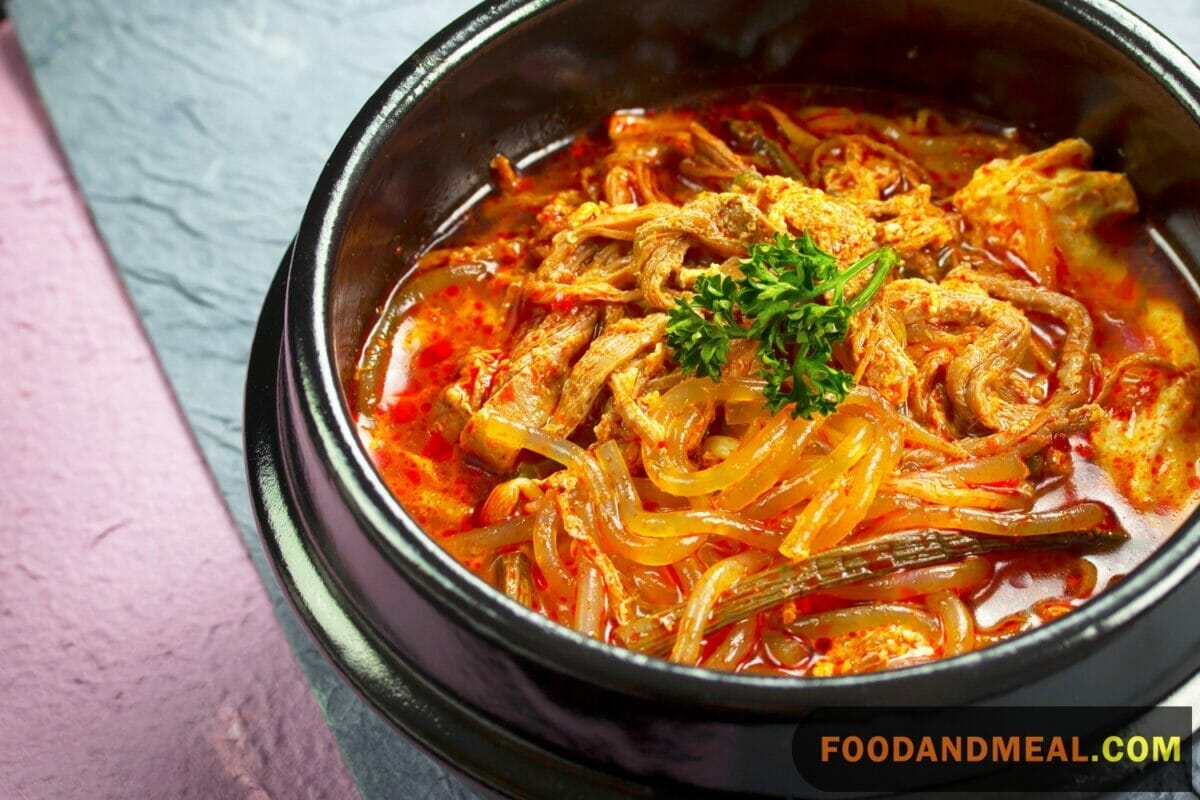As the crisp autumn air arrives, my thoughts turn to the rich, warming flavors of my childhood. I still remember coming home from school to the enticing aroma of my mom’s spicy beef stew simmering on the stove. She would lovingly ladle the tender beef and vegetables over a bowl of steaming white rice for me, the spices dancing on my tongue. I’ve missed that comforting taste of home since moving across the world for work. But now, as a recipe developer at Food and Meal, I’m so excited to share my mom’s Korean spicy beef stew (dakdoritang) so you can all enjoy a taste of my heritage.
This stew holds such nostalgia for me – the searing, complex heat of the gochujang chili paste, the unctuous boiled potatoes, the meat falling apart after hours of patient simmering. As an adult living far from my family, making this labor-intensive recipe connects me to generations of Korean mothers before me expressing their love through food. I hope that by sharing this beef stew recipe, you’ll feel wrapped in warmth and comfort with each spoonful. I’m getting hungry just thinking about the contrast between the tender beef and crunchy vegetables!

Spicy Beef Stew Recipe

SPICY BEEF STEW
Equipment
Ingredients
- 1 pound beef brisket, trimmed
- 8 scallions, cut into thirds
- 1 cup bean sprouts
- 3/4 cup dried presoaked fernbrake (gosari or bracken fern fiddleheads), rinsed
- 2 tablespoons minced garlic
- 2 tablespoons toasted sesame oil
- 2 teaspoons gochugaru
- 2 tablespoons gochujang or gluten-free gochujang
- 2 teaspoons soy sauce or gluten-free soy sauce
- 1 teaspoon freshly ground black pepper
- 2 eggs, lightly beaten
- 1 cup cooked glass noodles (optional)
Instructions
- In a large stockpot over high heat, bring the brisket and about 4 quarts of water to a boil.
- Immediately reduce the heat to low and simmer until the meat is tender, about 1 hour, skimming off the fat and foam that appear on the surface of the broth during cooking.
- Remove the meat from the broth, leaving the broth in the pot.
- When the meat is cool enough to handle, shred it along the grain with your hands or two forks.
- In a large bowl, combine the shredded beef with the scallions, bean sprouts, and gosari (fernbrake).
- Add the garlic, sesame oil, gochugaru, gochujang, soy sauce, and pepper.
- Add the meat mixture to the broth in the pot and bring to a boil. Reduce the heat to medium-low and simmer for about 5 minutes. Taste and add additional soy sauce, if needed.
- Swirl the beaten egg into the soup, stirring. Add the noodles (if using).
- Serve immediately.
Video
Notes
Nutrition
© Food And Meal
This website provides approximate nutrition information for convenience and as a courtesy only. Nutrition data is gathered primarily from the Spoonacular Database, whenever available, or otherwise other online calculators.
Korean Spicy Beef Stew Cooking Tips

First, choose fatty, well-marbled beef for the most luscious texture after long simmering. I admit I used to grab just any cheap cut, which led to disappointing stringiness. Splurging on short ribs or brisket makes all the difference! Browning the meat properly over high heat keeps the inside tender while adding tons of flavor.
My second tip is to really bloom the aromatics and chili paste before adding the broth. I cannot stress enough how huge a difference this makes! That extra time allows the garlic, ginger and gochujang to fully infuse the stew with their intoxicating essence.
Finally, cook low and slow once everything is combined, resisting the urge to rush the process. This was so hard for my impatient teenage self! But several hours of gentle simmering allows the meat to become knife-tender and the flavors to develop into a harmonious balance.
Serving Suggestions for Korean Spicy Beef Stew

Elevate your dining experience with the tantalizing flavors of Korean Spicy Beef Stew. For a unique twist, pair this hearty stew with the distinctive texture and umami taste of natto or indulge in a combination of savory delights by serving it alongside gyoza. Add a kick to the meal with wasabi, providing a contrasting element to the stew’s spiciness, or savor the delightful crunch of karaage as a satisfying accompaniment. For a refreshing touch, balance the heat with a glass of soy milk, or opt for the creamy and dairy-free option of oat milk. Explore diverse noodle combinations by serving yakisoba on the side, and bring a comforting touch with a bowl of miso soup. Enhance the richness of the stew by incorporating slices of pork chasu and complete the culinary journey with the subtly sweet taste of rice milk. Mix and match these serving suggestions to craft a personalized and delectable feast with Korean Spicy Beef Stew.
FAQs on Korean Spicy Beef Stew

As we delve into the intricacies of this sumptuous stew, it’s natural to have questions. Here are answers to some common queries:
- Can I use chicken instead of beef? Absolutely! Just ensure to adjust the cooking time as chicken tends to cook faster than beef.
- How spicy is this stew? The spice level can be adjusted. The original recipe has a good kick, but you can always reduce or increase the chili flakes to suit your palate.
- Is there a vegetarian version? Yes, you can substitute beef with hearty vegetables like mushrooms, tofu, or even jackfruit for a vegetarian take. Remember to adjust the cooking time accordingly.
- How long does it take to cook? The beef should be tender and the flavors melded, usually taking about 1.5 to 2 hours. However, the longer you let it simmer, the richer the flavors.
- How to store leftovers? Leftovers can be refrigerated in an airtight container for up to 3-4 days. For longer storage, consider freezing and reheating over the stove for the best texture and flavor.
Conclusion
As I come to the end of sharing my mom’s beloved Korean spicy beef stew, my heart is full of warmth. This soulful, complexly-spiced stew not only fills bellies but brings people together through the universal language of food. I’m so grateful to Food and Meal for providing me the platform to share this taste of my heritage.
If you make this labor-intensive but comforting classic, I hope it transports you through the intoxicating aromas and tenderly simmered beef. Let the spicy heat wrap you in a metaphorical hug, connecting you to generations of Korean mothers before you. This recipe isn’t just about ingredients coming together in a pot – it represents my history, my upbringing and my mom’s endless love, sealed with a kiss of gochujang spice.
I’d love to hear about your own adventures cooking this stew! Share your photos and stories over on the Food and Meal website or social channels. Maybe this beloved family recipe will become a new tradition in your home as well. Thank you for letting me share a taste of Korea with you today.
Hi! I'm Nazia of ‘Nazia Cooks’, a self-taught baker and cook residing in Chennai. Rooted in the rich South Indian culinary landscape, my palate has expanded to embrace global flavors. I revel in crafting fusion dishes, melding traditions to birth unique tastes.




